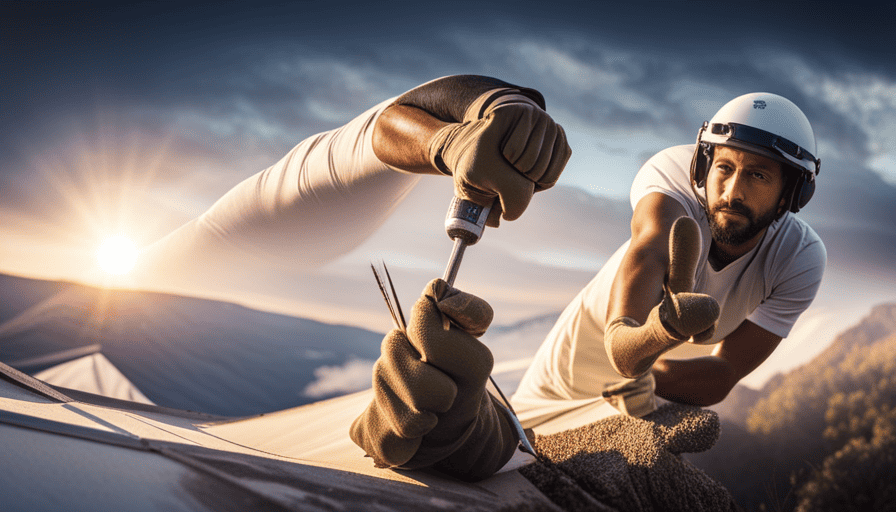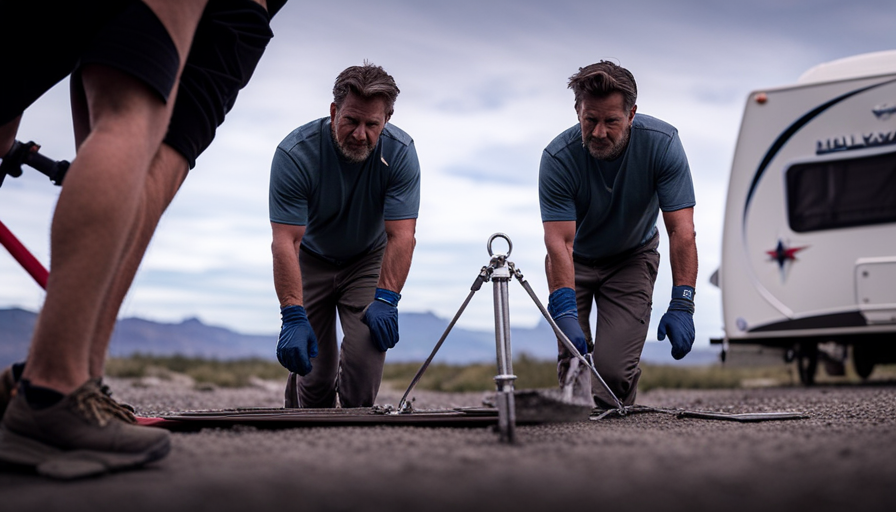Are you prepared to venture out and start thrilling journeys in your dependable camper? Before you head out, it’s essential to make sure that the roof of your camper is in perfect condition. Much like how a house’s roof safeguards its inhabitants from the weather, your camper’s roof provides protection against the rain, wind, and sun.
However, over time, wear and tear can take a toll on your camper roof, leading to leaks and other issues. But fear not! In this article, I will guide you through the step-by-step process of fixing your camper roof, so you can enjoy your travels worry-free.
From assessing the damage to reinforcing the roof with a protective coating, I will provide you with all the necessary tools, materials, and techniques to get your camper roof back in pristine condition.
Let’s get started!
Key Takeaways
- It is important to regularly inspect and maintain the camper roof to prevent damage and ensure it is in good condition before embarking on a trip.
- When repairing a camper roof, it is crucial to gather the necessary tools and materials, such as a caulking gun, putty knife, roofing sealant, and a rubber roof patch kit.
- Cleaning and preparing the roof surface is a crucial step before applying any repairs or sealants. This includes removing debris, sweeping away dirt, using mild detergent or camper roof cleaner to remove stains, and patching minor cracks and holes.
- Applying a waterproof sealant and reinforcing the roof with a protective coating are essential to protect against leaks and extend the lifespan of the roof. Regularly inspecting and maintaining the roof, as well as seeking professional help for complex repairs, are also important to prevent future issues.
Assess the Damage
Take a good look at the camper roof and see what kind of mess we’re dealing with. When it comes to roof repair tips, assessing the damage is the crucial first step.
There are several common causes of camper roof damage that you should be aware of. One of the most common causes is water leakage. Over time, if the roof isn’t properly sealed, water can seep through and cause damage to the structure.
Another common cause is physical damage, like tree branches falling on the roof or hailstorms. These can lead to cracks or punctures in the roof. Additionally, excessive heat and UV rays can cause the roof to deteriorate and become brittle.
To assess the damage, start by inspecting the entire roof surface. Look for any signs of water stains, discoloration, or sagging. Check for any cracks, punctures, or tears in the roof material. Pay attention to the seams and edges as these are often vulnerable areas. Make sure to also check the roof vents and skylights.
Once you’ve assessed the damage, you can move on to the next step of gathering the necessary tools and materials for the repair process.
Gather the Necessary Tools and Materials
Make sure you have all the essential tools and materials at hand, so you can hit the ground running when repairing the rooftop of your camper. Having the right equipment will save you time and effort during the repair process. Here is a list of necessary tools and materials you will need:
| Tools | Materials |
|---|---|
| Caulking gun | Roofing sealant |
| Putty knife | Rubber roof patch kit |
| Wire brush | Self-leveling sealant |
| Utility knife | Roofing adhesive |
Before starting the repair, take a few precautions. Ensure that the camper is parked on a flat and stable surface. Additionally, check the weather forecast, as it’s best to work on a dry day to allow the materials to adhere properly.
When repairing the camper roof, there are a few steps you should follow. First, clean and prepare the roof surface, as discussed in the subsequent section. Then, carefully inspect the damaged area and remove any loose or damaged materials. Next, apply the appropriate sealant or adhesive according to the instructions provided with the patch kit. Take care to avoid common mistakes, such as applying too much or too little sealant, which can compromise the effectiveness of the repair.
Transitioning into the subsequent section about cleaning and preparing the roof surface, it is important to start with a clean and debris-free surface to ensure proper adhesion of the repair materials.
Clean and Prepare the Roof Surface
Start by thoroughly inspecting the surface of your vehicle’s rooftop, ensuring it’s free of any dirt, debris, or loose materials that could hinder the repair process. Preventive measures should be taken to avoid any further damage to the camper roof.
Begin by removing any large debris or branches that may have accumulated on the roof. Use a stiff bristle brush or broom to sweep away dirt and dust particles. Be cautious not to scratch or damage the roof surface during this process.
Next, use a mild detergent or camper roof cleaner to remove any stubborn stains or grime. Apply the cleaner directly to the affected areas and gently scrub the surface using a soft sponge or cloth. Rinse the roof thoroughly with clean water to remove any residue.
Once the roof is clean and dry, inspect it closely for any cracks or holes. Patch minor cracks and holes using a camper roof repair kit, following the manufacturer’s instructions. Apply the patching material evenly over the damaged area, ensuring a tight seal.
Transitioning into the next section about patching minor cracks and holes, it’s important to address these issues promptly to prevent further damage to your camper roof.
Patch Minor Cracks and Holes
Inspect your vehicle’s rooftop closely for any small cracks or holes that may need to be patched. Roof maintenance is an essential part of ensuring the longevity and functionality of your camper. DIY repairs can save you time and money, allowing you to enjoy your outdoor adventures without worries. Patching minor cracks and holes is a relatively straightforward process that can be accomplished with a few tools and materials.
To begin, gather the necessary equipment: a putty knife, sandpaper, a patching compound, and a caulk gun. First, clean the area around the crack or hole using a mild detergent and water solution. Once the surface is dry, use sandpaper to smooth the edges of the damaged area. This will help the patch adhere better.
Next, apply the patching compound using a putty knife, ensuring that it covers the crack or hole completely. Smooth out the compound and let it dry according to the manufacturer’s instructions. Once dry, sand the patched area to achieve a seamless finish.
Incorporating a table can provide a visual reference for the materials needed and the steps involved:
| Materials Needed | Steps |
|---|---|
| Putty knife | Clean the area |
| Sandpaper | Smooth the edges |
| Patching compound | Apply the compound |
| Caulk gun | Smooth and let it dry |
By following these steps, you can effectively patch minor cracks and holes in your camper roof. However, if the damage is extensive, it may be necessary to replace damaged sections of the roof. Transitioning into the next section, we will explore how to tackle this more involved task of replacing damaged roof sections.
Replace Damaged Sections of the Roof
Replacing damaged sections of the roof can be a challenging yet necessary task when it comes to maintaining the structural integrity and aesthetic appeal of your camper. To effectively replace damaged sections, it’s important to first identify the extent of the damage and select the appropriate roofing materials.
Commonly used materials for camper roofs include aluminum, fiberglass, and rubber.
To begin the replacement process, carefully remove the damaged section of the roof using a pry bar or a screwdriver. Ensure that all nails or screws are properly removed to prevent any further damage. Once the damaged section is removed, measure and cut the replacement piece to fit the exact dimensions.
When selecting the replacement materials, it’s crucial to choose high-quality options that are durable and weather-resistant. This will ensure the longevity of the repair and provide adequate protection against the elements.
After the replacement section is cut and properly fitted, secure it in place using screws or nails. Make sure to seal all seams and edges with a waterproof sealant to prevent any potential leaks.
Replacing damaged sections of the roof requires precision and attention to detail. By choosing the right materials and following the proper installation techniques, you can restore the functionality and appearance of your camper’s roof.
Moving forward, let’s discuss how to apply a waterproof sealant to ensure maximum protection.
Apply a Waterproof Sealant
To ensure maximum protection, you should apply a waterproof sealant to safeguard against potential leaks and damage. Here are three key techniques to consider when applying a waterproof sealant to your camper roof:
-
Clean the surface: Before applying the sealant, it’s crucial to clean the roof thoroughly. Remove any debris, dirt, or loose materials using a brush or pressure washer. This step ensures that the sealant adheres properly and provides a strong bond.
-
Choose the right sealant: Select the appropriate sealant for effective roof protection. Look for a sealant specifically designed for camper roofs, as it’ll offer superior adhesion and durability. Consider factors such as weather resistance, UV protection, and compatibility with your roof material.
-
Apply the sealant: Once the surface is clean and the sealant is chosen, follow the manufacturer’s instructions for application. Use a brush or roller to evenly spread the sealant over the entire roof surface. Pay extra attention to seams, vents, and other potential leak points. Allow the sealant to dry completely before exposing the roof to any moisture or harsh weather conditions.
By applying a waterproof sealant using these techniques, you can effectively protect your camper roof from leaks and damage. In the next section, we’ll discuss how to reinforce the roof with a protective coating to further enhance its durability.
Reinforce the Roof with a Protective Coating
Enhance the durability of your camper roof by reinforcing it with a protective coating that adds an extra layer of strength and resilience.
When it comes to protecting your camper roof from the elements, there are various alternatives for a protective coating that can significantly increase its lifespan. One popular option is a rubber-based coating, which provides excellent waterproofing capabilities and helps prevent damage from UV rays. Another alternative is a liquid roof coating, which forms a seamless barrier that effectively seals any existing cracks or leaks.
Reinforcing your camper roof with a protective coating offers several benefits. Firstly, it helps to extend the lifespan of your roof by providing an additional layer of protection against potential damage from rain, snow, and other weather conditions. Secondly, the coating acts as a barrier against UV radiation, preventing the roof from deteriorating and fading over time. Additionally, a protective coating can help to minimize the risk of leaks, which can lead to interior damage and costly repairs.
Inspecting and repairing any interior damage is the next crucial step in maintaining your camper roof. By addressing any issues promptly, you can prevent further damage and ensure the longevity of your camper roof.
Inspect and Repair any Interior Damage
One important step in maintaining the longevity of your camper is inspecting and repairing any interior damage, which can help prevent further issues down the line.
Did you know that according to a recent survey, 45% of camper owners reported experiencing interior damage due to leaks? To ensure the structural integrity of your camper roof, it’s crucial to address any interior damage promptly.
To begin, thoroughly inspect the interior of your camper for signs of water damage. Look for discoloration, soft spots, or mold growth, as these are indications of leaks. Once you’ve identified the areas of concern, it’s time to implement repair techniques.
Start by removing any damaged materials, such as waterlogged insulation or deteriorated ceiling panels. Replace these with new, waterproof materials to prevent future leaks.
Common causes of interior damage include cracked or missing sealant around windows and vents, damaged roof seams, or worn-out roof vents. To fix these issues, apply a high-quality sealant to all vulnerable areas, ensuring a watertight seal. Additionally, inspect and repair any damaged roof seams using a suitable adhesive or sealant.
By addressing interior damage promptly and employing effective repair techniques, you can safeguard your camper against further issues.
Transitioning into the subsequent section about regular maintenance tips to prevent future roof issues, it’s crucial to stay proactive in your camper care routine.
Regular Maintenance Tips to Prevent Future Roof Issues
Make sure you regularly inspect and maintain your camper’s roof to prevent any future issues. Taking preventive measures and following proper roof maintenance tips can help extend the life of your camper’s roof and avoid costly repairs.
Here are some tips to consider:
-
Clean the roof regularly: Remove any debris, leaves, or branches that may accumulate on the roof. This will prevent clogs and ensure proper water drainage.
-
Check for any signs of damage: Inspect the roof for cracks, tears, or loose seals. Addressing these issues promptly can prevent water leaks and further damage.
-
Apply roof sealant annually: A layer of roof sealant can provide an extra barrier of protection against moisture and UV rays. Make sure to follow the manufacturer’s instructions for application.
-
Trim overhanging tree branches: Branches rubbing against the roof can cause scratches and damage the roof material. Regularly trim any overhanging branches to prevent this.
By following these preventive measures and regularly maintaining your camper’s roof, you can minimize the risk of future roof issues. However, if you encounter significant damage or are unsure about the necessary repairs, it’s always advisable to seek professional help.
Seek Professional Help if Needed
If you’re unsure about the necessary repairs, it’s always advisable to seek professional help to ensure the longevity and proper functionality of your camper’s roof. Seeking professional advice is crucial when it comes to fixing a camper roof, as it requires technical knowledge and expertise.
While there are DIY options available, it’s important to understand the complexity of the task and the potential risks involved. Professional help can provide you with a thorough assessment of the damage and recommend the best course of action. They have the necessary tools and experience to handle any roof issues effectively and efficiently. Additionally, they can ensure that the repairs are done correctly, preventing further damage and potential leaks.
However, if you’re confident in your skills and have experience in roof repairs, there are some DIY options available. It’s important to research and educate yourself on the specific techniques and materials required for camper roof repair. Follow step-by-step instructions and safety precautions to minimize any risks. Keep in mind that DIY repairs may void any warranties or insurance coverage, so it’s crucial to weigh the pros and cons before proceeding.
Seeking professional help is recommended when fixing a camper roof. Their expertise and knowledge can ensure a long-lasting and properly functioning roof. However, if you have the necessary skills and knowledge, DIY options can be considered, but proceed with caution and thorough research.
Frequently Asked Questions
How much does it cost to fix a camper roof?
Fixing a camper roof can vary in cost depending on the extent of the damage and the materials needed. However, if you’re looking for budget-friendly options, DIY camper roof fixes can be a great solution. By following camper roof repair tips and using affordable materials, such as sealants and patch kits, you can effectively repair your camper roof without breaking the bank.
Remember to assess the damage properly and prioritize safety when attempting any DIY repairs.
Can I use regular household tools for camper roof repair?
Yes, regular household tools can be used for camper roof repair, though specialized camper roof repair tools are recommended for best results. Some alternative household tools that can be used include a putty knife for removing old sealant, a heat gun for softening the roof material, and a roller for applying new sealant. However, it’s important to note that using the correct tools specifically designed for camper roof repair will ensure a more efficient and effective repair.
Are there any specific cleaning products I should use to prepare the roof surface?
To ensure proper adhesion and a long-lasting repair, it’s crucial to thoroughly clean the roof surface before fixing a camper roof. There are several cleaning techniques you can use, but I recommend using a mild detergent and warm water. This will effectively remove dirt, grime, and any existing coatings.
However, if you prefer alternative cleaning methods, you can also consider using a vinegar solution or a specialized camper roof cleaner.
How long does it take for a waterproof sealant to dry?
To ensure a proper application of waterproof sealant, it’s essential to understand the drying time. The duration for a waterproof sealant to dry varies depending on the specific product and environmental conditions. Generally, it can take anywhere from a few hours to a couple of days for the sealant to fully dry and create an effective waterproof barrier.
It’s crucial to choose the right waterproof sealant that suits your camper roof’s material and follow the manufacturer’s instructions for optimal results.
What are some common signs of interior damage that may be caused by a damaged camper roof?
Some common signs of interior damage that may be caused by a damaged camper roof include water stains on the ceiling or walls, warped or discolored wood, mold or mildew growth, and a musty smell.
To address these issues, various roof repair methods can be used. These include identifying and sealing any leaks, replacing damaged materials, and repairing water damage.
It’s important to address these issues promptly to prevent further damage to the camper’s interior.
Are the Steps to Fixing a Camper Slide Out Similar to Fixing a Camper Roof?
Fixing a camper slide out is a different process compared to fixing a camper roof. While both involve repairs, slide out issues usually revolve around the mechanical aspects of the extension mechanism. In contrast, fixing a camper roof often entails sealing leaks, repairing damage, or replacing sections. Each problem requires specific expertise and tools, emphasizing that the steps differ for slide out and roof repairs.
Conclusion
In conclusion, fixing a camper roof requires careful assessment, preparation, and repair. By following the steps outlined in this article, you can successfully restore your camper roof to its former glory. Remember to regularly maintain your roof to prevent future issues.
Did you know that according to a survey conducted by RV Travel, roof leaks are one of the most common problems faced by camper owners, accounting for over 40% of reported issues? Taking proactive measures can help you avoid costly repairs in the long run.











